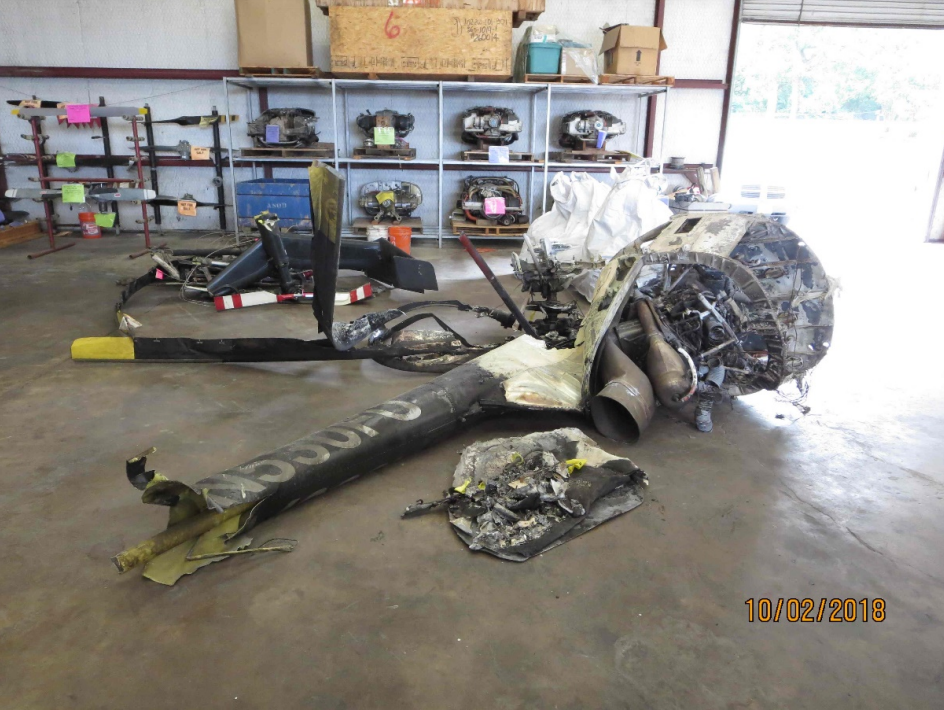
ASN Wikibase Occurrence # 214584
This information is added by users of ASN. Neither ASN nor the Flight Safety Foundation are responsible for the completeness or correctness of this information.
If you feel this information is incomplete or incorrect, you can submit corrected information.
| Date: | Tuesday 21 August 2018 |
| Time: | 12:18 |
| Type: |  Hughes 369F |
| Owner/operator: | Air 1 Sandpoint Helicopters Inc opb. Brunner Aerospace |
| Registration: | N530FU |
| MSN: | 0005F |
| Year of manufacture: | 1984 |
| Total airframe hrs: | 17399 hours |
| Engine model: | Rolls Royce 250-C30 |
| Fatalities: | Fatalities: 2 / Occupants: 2 |
| Aircraft damage: | Destroyed |
| Category: | Accident |
| Location: | Granger, TX -
 United States of America United States of America
|
| Phase: | En route |
| Nature: | Training |
| Departure airport: | Georgetown Municipal Airport, TX (GTU) |
| Temple-Draughon-Miller Airport, TX (TPL/KTPL) | |
| Investigating agency: | NTSB |
| Confidence Rating: |
The flight instructor was providing emergency procedure refresher training, as part of a contract between the US Army and a private contractor, to special operations pilots with the Jordanian Air Force. The accident was intended to be an introductory orientation flight for the pilot receiving instruction of the airports areas where the training would be occurring.
Radar data indicated that the helicopter traveled east from the departure airport and climbed to an altitude of about 500 ft above ground level (agl). Afterward, the helicopter began to descend, and flew at altitudes that varied between 0 and 120 ft agl at a groundspeed of about 90 knots. A witness saw the helicopter rapidly approaching his location and reported that the helicopter was flying low in a nose-down attitude.
A short time later, the helicopter struck and severed a steel wire power distribution line, and continued to fly until the helicopter impacted the ground about 950 ft beyond the impact point with the line. Most of the severed power line was continuous to the main wreckage location, having likely trailed or been attached to the helicopter after impact. According to the radar data, and impact trajectory, the 36-ft-tall power line support poles would have been hidden from the pilots' view by a stand of trees as the helicopter approached the area.
Postaccident examination revealed no anomalies with the airframe or engine that would have precluded normal operation of the helicopter. The wreckage location, which was well beyond the impact point with the power line, was consistent with the helicopter operating at a high forward speed and likely a high engine power.
The flight instructor was highly experienced in the accident helicopter make and model and had an extensive military career flying attack missions in helicopters. These missions included navigation and aerial gunnery, which would have required low-level flight close to terrain. Likewise, the pilot receiving instruction flew similar attack missions in helicopters with the Jordanian military. Therefore, it is likely that the flight instructor decided to intentionally deviate from the training syllabus and perform, or allow the pilot receiving instruction to perform, a high-speed, nap-of-the-earth flight for personal reasons, possibly to simulate their working environment, make the flight more interesting or engaging, push limits, or impress each other.
The flight instructor had used the sedating antihistamine cetirizine at some time before the accident flight. Although the levels of the drug were well below the therapeutic range, it is not possible to determine if he could have been impaired by the sedating effects during the accident sequence.
Probable Cause: The failure of both pilots to see and avoid a power line while maneuvering at low altitude. Contributing to the accident was the flight instructor's decision to not follow the training syllabus and allow the low-level high-speed flight.
Accident investigation:
 |
|
Sources:
NTSB
FAA register: http://registry.faa.gov/aircraftinquiry/NNum_Results.aspx?NNumbertxt=530FU
History of this aircraft
Other occurrences involving this aircraft
| 24 May 1990 | N530R | Rogers Helicopters, Inc. | 0 | Madera, CA |  |
sub |
| 14 May 2008 | N530R | Inter-Island Helicopters | 0 | near Kekaha, Kauai, HI |  |
sub |
| Heavy landing | ||||||
Location
Images:


Photos(c): NTSB
Revision history:
| Date/time | Contributor | Updates |
|---|---|---|
| 21-Aug-2018 19:16 | gerard57 | Added |
| 21-Aug-2018 19:44 | Aerossurance | Updated [Time, Location, Source, Narrative] |
| 21-Aug-2018 19:45 | Aerossurance | Updated [Source] |
| 21-Aug-2018 19:47 | Aerossurance | Updated [Source, Narrative] |
| 21-Aug-2018 20:53 | Aerossurance | Updated [Aircraft type, Operator, Nature, Source] |
| 21-Aug-2018 22:21 | Geno | Updated [Aircraft type, Registration, Cn, Operator, Location, Departure airport, Destination airport, Source, Narrative] |
| 22-Aug-2018 09:28 | Captain Adam | Updated [Nature, Source, Narrative] |
| 22-Aug-2018 13:48 | harro | Updated [Aircraft type] |
| 22-Aug-2018 13:59 | harro | Updated [Registration, Cn, Operator, Source, Narrative] |
| 22-Aug-2018 14:00 | harro | Updated [Aircraft type] |
| 22-Aug-2018 14:02 | harro | Updated [Source] |
| 15-Aug-2020 16:00 | ASN Update Bot | Updated [Time, Operator, Departure airport, Destination airport, Source, Narrative, Accident report, ] |
| 06-Mar-2022 01:44 | Captain Adam | Updated [Operator, Location, Departure airport, Destination airport, Source, Narrative, Category, Photo] |
| 06-Mar-2022 01:44 | Captain Adam | Updated [Photo] |
| 04-Dec-2023 14:31 | harro | Updated [Other fatalities] |
Corrections or additions? ... Edit this accident description
The Aviation Safety Network is an exclusive service provided by:


 ©2024 Flight Safety Foundation
©2024 Flight Safety Foundation